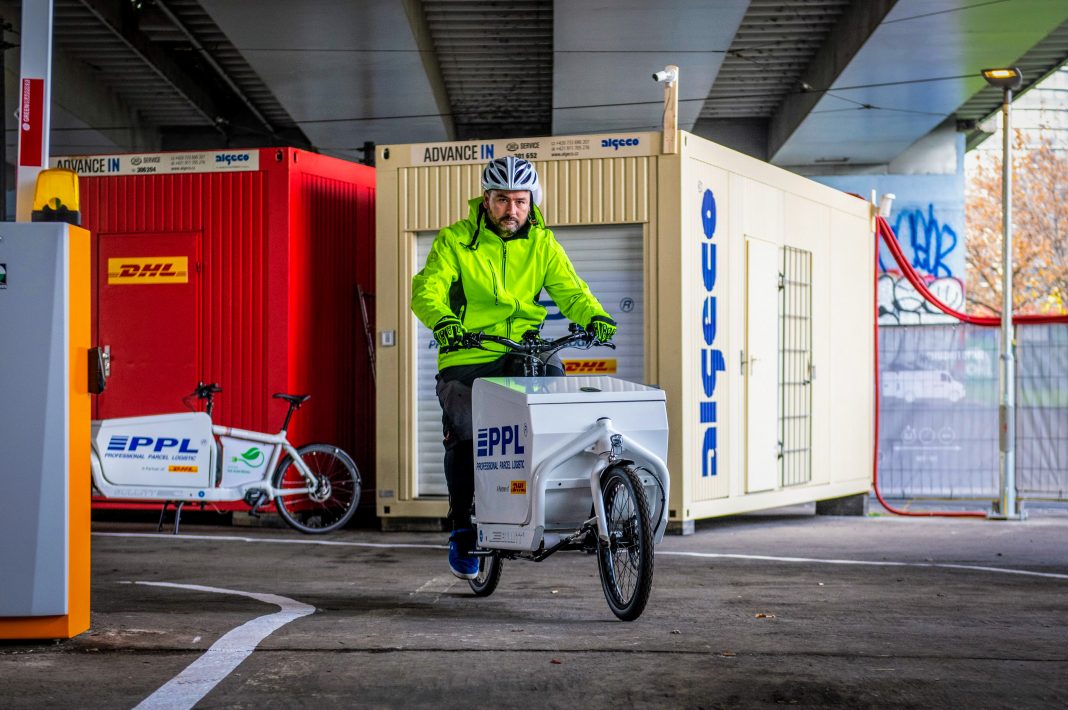Cargo bikes and trikes are fast, flexible, they offer large storage capacity, and on top of all that, they produce zero tailpipe emissions. In other words, cargo bikes are the perfect fit for deliveries and parcel pick-ups in dense urban areas.
From a Niche Solution Towards Mainstream
Cargo bikes are not exactly a new phenomenon. On the contrary, their history dates back to the 19th century. Due to high production costs, however, cargo bikes remained a niche solution for the years to follow.
But not anymore. Times have changed. The latest statistics only confirm what we have known for some time now: cargo bikes are gaining momentum. And not just for private use. The number of bike couriers is steadily increasing, and more and more logistics companies are turning to cargo bikes too. But what is it that makes these vehicles such a good fit for deliveries in urban areas? Why cargo bikes? Why now?
The Case for Cargo Bikes
The short and simplified answer to these questions is “Because it makes sense!”. We are trying so hard (hard enough?) to tackle climate change, to make our cities more liveable, healthier, happier places, to decarbonize our transport system and the way goods are moved through our cities. If cargo bikes can help us take a big step in the right direction, shouldn’t we take a chance?
Here are some arguments that make the case for cargo bikes and show why we should advocate for a wider uptake of cargo bikes and trikes in city logistics.
1. Stuck in traffic? Not anymore.
We all know the picture too well: narrow, congested city streets, delivery drivers desperately searching for a parking spot, eventually surrendering to the fact that there is none and parking their vans and trucks in second row. Under these circumstances, it seems quite clear that putting even more diesel trucks on the streets to handle the growing parcel volumes can only prove to be a dead end.
Definitely not a dead end but rather a fast lane to alleviating traffic congestion in cities is the use of cargo bikes for deliveries. They are smaller in size, more flexible and manoeuvrable than vans and trucks, and on top of that, cargo bikes and trikes can access cycle lanes. In other words, they enable their drivers to bypass traffic, take more direct routes and save valuable time. Needless to say, parking is also significantly easier than with a big van or truck.
2. Efficient in combination with logistics hubs.
Cargo bikes are very efficient on both the first and last mile, especially in combination with a hub. Using a container or a bigger vehicle as a micro hub or micro depot for bundling goods has one major advantage: it reduces the actual distance of the last mile and makes the use of cargo bikes a viable option.
A great number of successful projects in- and outside of Europe proves that the concept works: From cities that collaborate with logistics companies and other key stakeholders in setting up a cycle logistics hub, e.g. the Depot.Bike project in Prague, to cycle logistics companies which have known about the great potential of these vehicles for a long time.
Zedify is one of these examples. The logistics service provider is currently operating in 10 different cities across the UK – each with its own depot and a sustainable vehicle fleet (mainly cargo bikes and trikes). Having these depots allows Zedify to bundle deliveries for the last mile, which doesn’t only make them an attractive business partner for retailers in the city but national carriers too. Instead of entering the city with a large truck and delivering several smaller customers, the depot allows carriers to drop off their goods at the edge of the city and let Zedify do the rest – in a sustainable way. “From their point of view, it’s probably like a win-win”, knows Rob King, Co-Founder of Zedify, who is convinced that cargo bikes are just the perfect solution for deliveries in dense urban areas.
3. Not suitable for all kinds of deliveries, but probably more than you’d think.
According to the EU Cycle Logistics Project, 25 % of all goods and 50 % of all light goods could be transported by bicycle in EU cities. That’s a good start, right?
Cargo bikes have seen great development over the past years – both in terms of technology as well as design: There are bikes with swappable boxes, electrical drive units, batteries providing for a range of up to 40 km, starting aid and reverse gear, three- and four-wheeled models, bikes with protection against the weather and for better driver safety. Loading volumes vary, depending on brand and model. However, payloads of over 200 kg and loading volumes of 1 to 2 m2 are very common, which make cargo bikes perfectly suitable for courier, parcel and express deliveries.
4. Better for the environment and our cities.
Besides the fact that cargo bikes need less space, they are also the better option when it comes to carbon emissions, local air pollution and noise. A recent study showed that replacing a 3.5 t delivery truck in the centre of London with a cargo bike leads to savings of approx. 6 t of CO2, a minimum of 14.1 kg NOx, as well as 21 g PM (based on an average distance of 80 km/day).
But it’s not just the use phase of cargo bikes that proves to be more sustainable than that of a car. Production is considerably less material- and energy-intensive too. Based on relative weight, cargo bikes or trikes only account for approximately 4 % of the embodied energy that is used for the production or disposal of a 3.5 t van.
Ultimately, the question of sustainable goods transport is one of liveability too. When we focus on what people really want from their cities, such as safe neighbourhoods or vibrant strees, it becomes rather clear that the movement of goods is one critical aspect. If we really want to create liveable cities, there’s just no way around cargo bikes or trikes.
More Than Just Another Mode of Transport
Cargo bikes are probably not a panacea for all traffic-related problems that cities are currently struggling with such as congestion, limited space or pollution. However, there’s great potential for cargo bikes to play a vital role in urban deliveries.
At one point during a conversation with Jakub Ditrich, project founder of DEPOT.Bike, a cycle logistics hub in Prague, he said something that once again made clear that cargo bikes are much more than just a mode of transport that helps to move goods from A to B:
“It is quite important that people understand that the bicycle is not just the vehicle with one seat and two wheels, but it could be anything else.”
With that in mind, let’s focus on the “anything else”-part and pedal faster towards a greener and more efficient city logistics.


